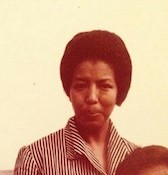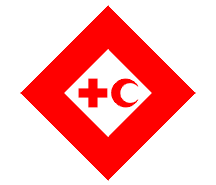The structure of this miniature biography has been taken from the English Wikipedia entry about her, but interspersed with information from other sources, especially with regard to her activities with the Red Cross.
“Woizero Senedu Gebru (ሰንዱ ገብሩ) (13 January 1916 – 20 April  2009) was an Ethiopian educator, writer and politician. In 1957, she became the first Ethiopian woman elected to Parliament[i]”.
2009) was an Ethiopian educator, writer and politician. In 1957, she became the first Ethiopian woman elected to Parliament[i]”.
“Early life and resistance
Gebru was born on 13 January 1916 in Menagesha. Her father, Gebru Desta, was a European-educated writer and former mayor of Addis Ababa and briefly president of the senate. Her mother, Weyzero Kasaye Yelamtu, was an Ethiopian Orthodox Christian and raised her in the faith. She was educated locally at the Swedish Mission School before being sent to Switzerland in 1928 for higher studies. She did not like the school, so she was sent to a school in France, where she learned French and English. She also discovered a love for literature, and earned a degree in the subject at Lausanne University in Switzerland. In 1932, she moved back to Ethiopia to find a position as a teacher at the St. George School in Addis Ababa and married for the first time. In addition to teaching, she interpreted for foreign journalists.
Gebru became politically active in the 1930s resisting the Italian occupation of Ethiopia. Along with her brothers, she was involved in the opposition movement led by Haile Selassie. She moved to Goré in Illubabor Province, where she joined with 100 cadets from a military academy and received some military training. Her group traveled to Neqemte, where she tried to arouse resistance to the Italians and was nearly captured. Gebru moved back to Goré, where she joined the Black Lions and established a Red Cross Unit after receiving some medical training. Gebru served as an informant for the Black Lions about Italian troop movements. Eventually, after catching pneumonia, she was captured by the Italians and interrogated. Meanwhile, her brother was killed on 19 February 1937. She later wrote a play about this event. Her rebellious behavior resulted in her being imprisoned on the Italian island of Asinara along with her father and sister. She was repatriated to Ethiopia in 1939.
Literary and political career
After Gebru returned to Ethiopia, she found a job at the Weyzero Sihïn school in Desé in 1941. Gebru was appointed assistant director of the first girls’ school in Ethiopia, the Empress Etege School, in 1943. She became headmistress two years later, a first in Ethiopian history. She instituted a number of innovations, such as taking girls for picnics on Mount Intoto and having them perform plays she wrote to enhance their public speaking abilities.
She was a writer in the Amharic language, and in 1956 published a collection of short stories, songs and poems entitled YaLebbe Meshaf (Book of My Heart). This was the only book she would write, although she produced a number of popular plays such as Keyekketit quenoch (Days in February). The following year, she was elected to the Parliament of Ethiopia, the first woman to do so. She was named vice president of the Chamber of Deputies on 22 November. She advocated complete parity between men and women and institution of the Civil Code. She served four years in Parliament and tried to end flogging of criminals, although this met some resistance. After her stint in Parliament, Gebru served in a number of important positions, such as the leader of the Ethiopian Red Cross and secretary-general of the Ministry of Social Affairs[ii]”.
The Historical Dictionary of Women in Sub-Saharan Africa has an entry for Senedu Gabruwhich gives a similar summary of her life, but much shorter:
“SENEDU GABRU (1915- ). Senedu Gabru was the first woman elected to Ethiopia’s parliament in 1957, and she was a prominent educational leader. She was born to an elite family and educated by missionaries in Switzerland. She returned to work as a teacher in Ethiopia, and was politically active in the resistance to Italian incursions in the 1930s. In 1945 Senedu was named assistant director of the first girl’s school in Ethiopia, the Empress Menen School that had been founded in 1931 by the former empress. In 1949 she became the first Ethiopian headmistress, and through her interest in improving educational opportunities for girls she entered politics[iii]”.
A much later academic work[iv] which includes observations about Senedu Gabru tries to balance the view of her as a product of her Swiss education and westernizing influences:
“However, it would be a very narrow interpretation to attribute Senedu’s active role in the political and social sphere solely to her acquaintance with western education. Senedu’s introduction to public life started when she was quite young. As a child she used to accompany her father Kentiba (Mayor) Gebru in some of his official visits to the imperial palace and other public places, and this exposure to
Ethiopian public life surely contributed to her knowledge of the running of Ethiopian political life.
Moreover, similar to her predecessors, Emperess Taytu and other Ethiopian women who fought in the military against the Italian colonial invasions, she joined at an early age the resistance movement of young Ethiopians known as the Black Lions, led by Ras Imru Haile Selassie,48 in which she spent three years until her capture as a freedom fighter by the Italians. “I think she sees herself as an anti-fascist resistance [fighter], a person of the anti-fascist resistance, more than anything else, and I think that shaped her identity” her son Samuel Assefa comments in a video (Terusew 2015) commemorating her legacy for Ethiopian society in general and Ethiopian women in particular”.
Mrs Senedu Gabru was present at the 19th International Conference which took place in New Delhi in October/November 1957, representing the Ethiopian Red Cross Society[v]. She had with her a colleague, Mr. Kebede Abozin but the Ethiopian Government appears not to have been represented.
In April 1964 the International Review published an article by Senedu Gabru, with the headline From Lint to the Inspection of Vessels: The Amazing Development of Red Cross Tasks[vi], a reproduction of the lecture she had given in the Lecture Hall of the University of Geneva in August 1963, in the context of the 100th anniversary of the Red Cross. When she spoke, it was in the twin capacities[vii] of “Member of the Presidential Council of the Ethiopian Red Cross” and “Vice Chairman of the Board of Governors of the League.
In this article Senedu Gabru spends most of the space available on a comparatively standard historical review of the history of the Movement, but towards the end situates it in the context of striving for peace, which may be worth reading in the present:
“To-day man enjoys the fruits of civilization which he requires a happy life, yet in fact he lives under the constant threat of a war which could reduce to nought the progress which has been achieved by dint of so much labour. And it is I think the fate of man to-day which must be the subject of our concern. His life is a profound contradiction, for he seems to observe the paradox of our times, powerless to do anything about it and often resigned to it, whereby millions are spent on medical research in order to isolate the bacteria which are noxious to health, whilst at the same time even more millions are allocated to means of mass slaughter.
Let me say that those of us who have come from far and who aspire to modern civilization are confounded by this contradiction. I have admired, to the point of envy I must admit, the meticulous care devoted to your babies, but it seems to me that all this care is futile if it has to be accompanied by the passive acceptance of weapons which will make of your sons both target and killer. From this point of view, it would seem that man’s forward march over thousands of years has not taken him far; he has even been doing nothing more than mark time.
The Red Cross has drawn up Conventions to protect the wounded. Could it have a convention for the protection of mankind today which would eliminate this contradiction and for ever prevent men sound in mind and body from becoming wounded?[viii]”

In 1965, in September, Senedu Gabru was in Oslo, visiting the Norwegian Red Cross which celebrated its 100th anniversary this year[ix]. She was there in her capacity as Vice Chair of the League – but the local media referred mostly to Ethiopia except on one occasion, when it was mentioned she represented the “International Red Cross”. But she addressed one of the main events, presided over by H.M. King Olav V and H.R.H. Princess Astrid Mrs. Ferner and shared the podium on that occasion with Mr Einar Gerhardsen, the then Prime Minister of Norway, and General A. E. Martola, President of the Finnish Red Cross, representing the Nordics. Otherwise, there were events like an audience with King Olav for Red Cross Office-bearers, and a dinner at the Castle of Akershus, offered by the Cabinet[x].
In one case the newspaper in question, Arbeiderbladet – a Labour party organ – managed to get it right, that was a Vice Chair of the League, and also included a Norwegian translation of a small portion of the speech:
“– By introducing the Red Cross in distant lands, the Norwegian Red Cross has played an important role, said madame Gabru, and expressed her admiration for the Norwegian Red Cross which had heard Ethiopia’s pleas when the country found itself at war. Distance did not stop the Norwegian Red Cross from unselfishly to use all its strength for a people they never had met before[xi]”.
“Later life
Gebru was married three times. Her third husband, Aseffa Lemma, was appointed ambassador to Germany in 1968. She followed him to Bonn as an educational attache. The outbreak of the Ethiopian Civil War in 1974 caused him to seek exile there, but she returned to Ethiopia. She continued to write, and donated some plays to the Institute of Ethiopian Studies at the Addis Ababa University. Gebru was a regular contributor to the “women’s column” in the Amharic newspaper Addis Zemen.[1] Her son, Samuel Assefa, was ambassador to the United States.
Gebru died on 20 April 2009[xii]”.
There is much more to know about Senedu Gabru, both as subject of biographical writings, from her own written works, and from academic and political writings, but most of this appears to exist, so far, only in physical form and not available to the present author.
____________________________________________________
[i] https://en.wikipedia.org/wiki/Senedu_Gebru
[ii] https://en.wikipedia.org/wiki/Senedu_Gebru
[iii] Kathleen E. Sheldon; Historical Dictionary of Women in Sub-Saharan Africa, p 223, seen 2020.02.03 at https://books.google.no/books?id=36BViNOAu3sC&pg=PA223&lpg=PA223&dq=%22Senedu+Gabru%22&source=bl&ots=4ViUaHexcN&sig=ACfU3U2czKMpkFHCac4n1FsuhyWFChjgJQ&hl=en&sa=X&ved=2ahUKEwiz6NfR9bTnAhXntYsKHV1uBZoQ6AEwAXoECAoQAQ#v=onepage&q=%22Senedu%20Gabru%22&f=false
[iv] Abye, Tigest; Life story narratives of Ethiopian women activists: the journey to feminist activism; University of Bradford thesis 2016, pp 117-118; https://bradscholars.brad.ac.uk/bitstream/handle/10454/15864/Tigest%20Abye%20final%20PhD%20june%20%202017.pdf?sequence=1&isAllowed=y
[v] XIXth International Conference of the Red Cross, New Delhi, October – November 1957, Proceedings; https://library.icrc.org/library/docs/DIGITAL/CI_1957_RAPPORT_ENG.pdf; p 10.
[vi] https://international-review.icrc.org/sites/default/files/S0020860400001595a.pdf; p 171
[vii] https://international-review.icrc.org/sites/default/files/S0020860400001595a.pdf; p 180
[viii] https://international-review.icrc.org/sites/default/files/S0020860400001595a.pdf; p 180
[ix] International Review of the Red Cross; Fifth Year, No 57, December 1965; pp
[x] Arbeiderbladet (Oslo), 18.09.1965; https://urn.nb.no/URN:NBN:no-nb_digavis_arbeiderbladetoslo_null_null_19650918_0_216_1
[xi] Arbeiderbladet (Oslo); 23.09.1965; https://urn.nb.no/URN:NBN:no-nb_digavis_arbeiderbladetoslo_null_null_19650923_0_220_1
